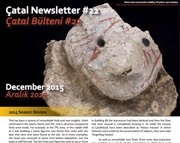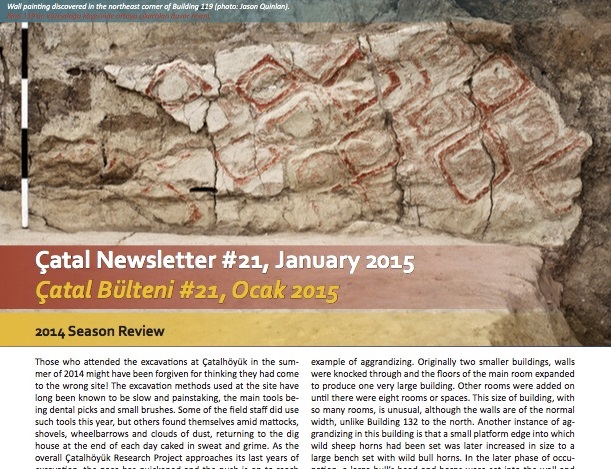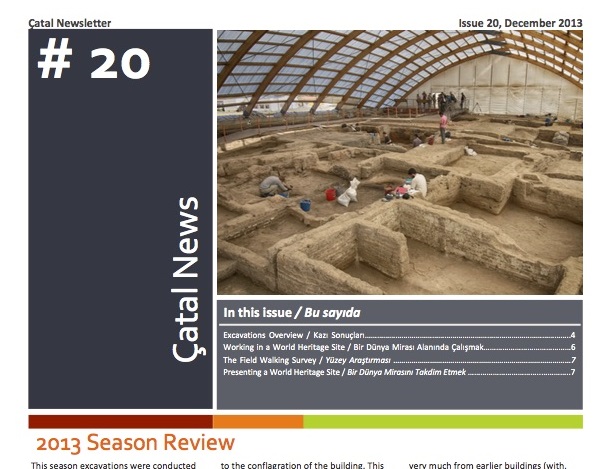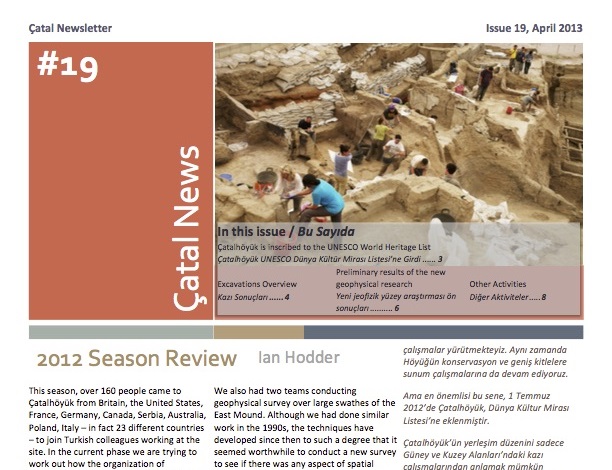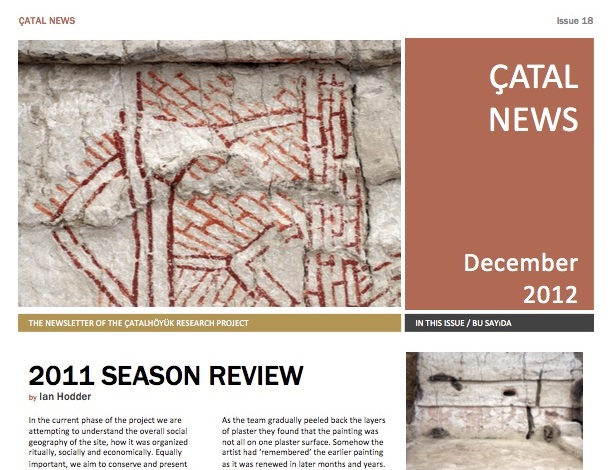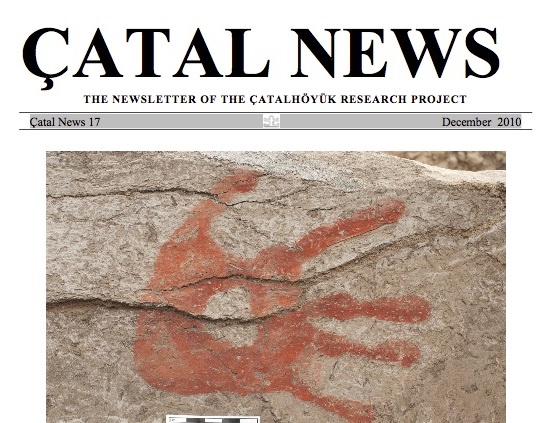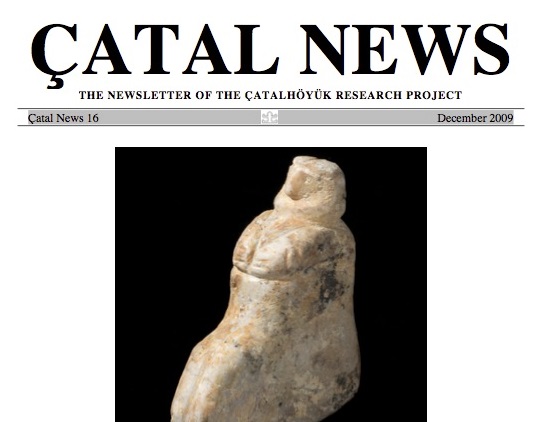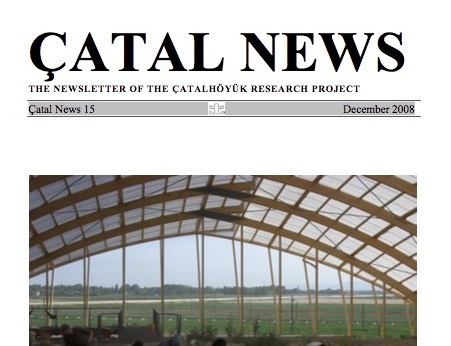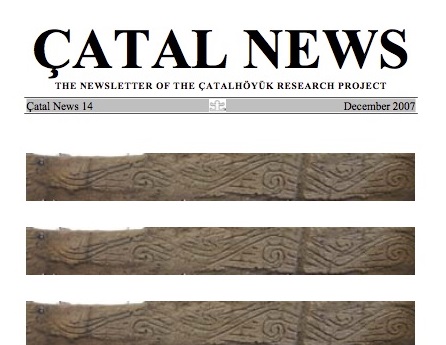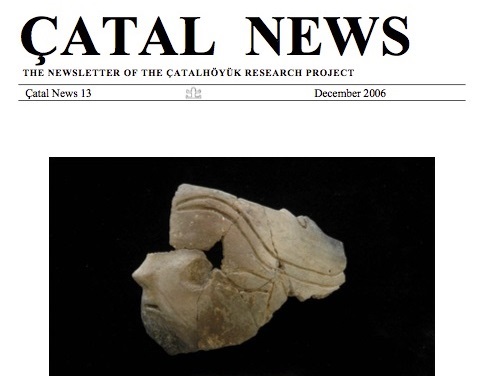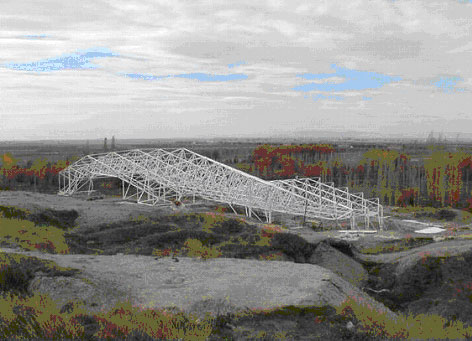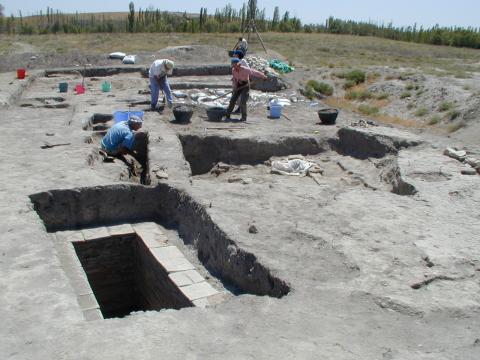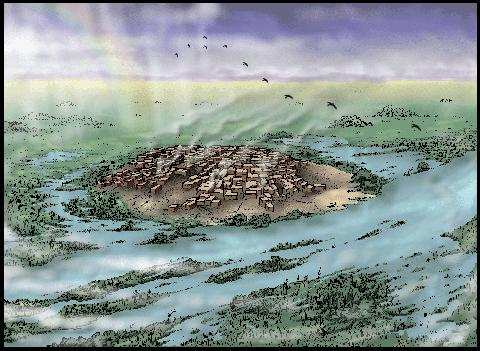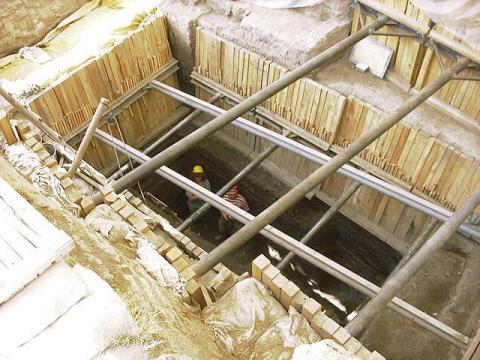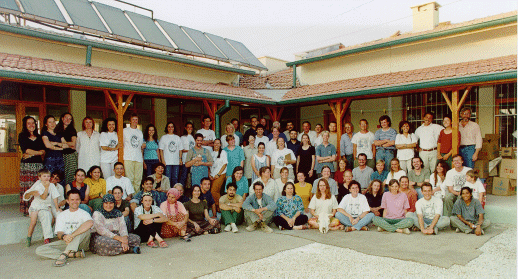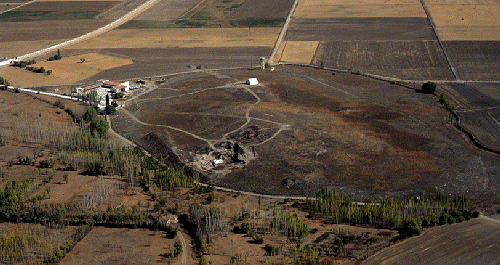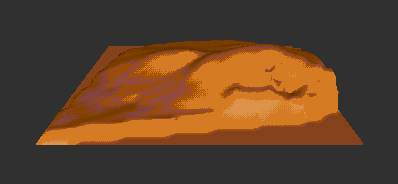January 19, 2016, 11:07 am
Electrum: Studia z Historii Starożytnej / Journal of Ancient History
ISSN 1897-3426
e-ISSN 2084-3909
![http://www.ejournals.eu/resources/1/top_electrum.jpg]()
Electrum has been published since 1997 by the Department of Ancient History at the Jagiellonian University in Cracow as a collection of papers and monographs. In 2010 it starts as journal with one issue per year.
Journal publishes scholarly papers embodying studies in history and culture of Greece, Rome and Near East from the beginning of the First Millennium BC to about AD 400. Contributions are written in English, German, French and Italian. The journal publishes books reviews.
Volume 19 (2012)
Volume 18 (2011)
Volume 16 (2010)
Volume 15 (2009)
↧
January 19, 2016, 11:51 am
L’Année épigraphiqueISSN: 0066-2348
L’Année épigraphique (citée AE) est une publication annuelle qui fournit une analyse critique des inscriptions grecques et latines et des études fondées sur l’épigraphie relatives à l’Antiquité romaine, publiées au cours de l’année de référence de la publication. Ces inscriptions (développées et restituées) et ces études y sont présentées sous une forme ordonnée (selon la géographie administrative de l’empire romain) et sont assorties d’indices hiérarchisés. Ainsi AE 2011 a été imprimée en août 2014 et AE 2012 en août 2015. AE 2013 est en préparation.
L’Année épigraphique est un instrument de travail mis à la disposition de la communauté scientifique internationale depuis plus d’un siècle. Fondée en effet en 1888 par René Cagnat et dirigée depuis février 1992 par Mireille Corbier, L’Année épigraphique est rédigée et mise au point par une équipe internationale de chercheurs, philologues et historiens, recrutés pour leurs compétences et pour la complémentarité de leurs spécialisations, qui produisent un ouvrage original, dans lequel ils investissent un savoir accumulé en épigraphie et en histoire des sociétés anciennes (voir le site www.anneeepigraphique.msh-paris.fr).
Depuis AE 1991 (publiée en 1994) L’Année épigraphique fait une plus large place que par le passé aux inscriptions grecques relatives au monde romain (dont elle propose pour les plus longues d’entre elles une traduction), aux inscriptions chrétiennes et aux inscriptions liées à la vie quotidienne (graffiti, textes sur instrumentum). L'indexation des données, réalisée par les rédacteurs des notices, facilite leur identification et leur utilisation.
Le volume annuel, imprimé et diffusé par les PUF, propriétaires de l’entière collection, est vendu par abonnement ou à l’unité. Des versions numériques sont proposées sur les plateformes JSTOR et CAIRN.INFO.
Liste des numéros
↧
↧
January 20, 2016, 7:22 am
[First posted in AWOL 30 January 2013, updated 20 January 2016] University of Pennsylvania Museum of Archaeology and Anthropology (Penn Museum) at tDAR: Publications with digital supplementary material ![http://www.tdar.org/wp-uploads/www.tdar.org//2013/01/logo_black1-300x79.jpg]()
Digital Antiquity is pleased to announce the University of Pennsylvania Museum of Archaeology and Anthropology (PennMuseum) collection in tDAR. Digital curators created metadata and uploaded all of the digital supplementary material from 18 books published by the Penn Museum.
These incredible materials include rich data sets, images, and reports, all available for download by registered tDAR users. tDAR’s content is indexed by major search engines, and exposes the Penn Museum’s published digital content to searchers who may otherwise be unaware of these books and their associated digital media.
The books themselves are available for purchase at the University of Pennsylvania Press (Penn Press) website at http://www.upenn.edu/pennpress/series/UPM.html.
Registration (free of charge) is required for access to material in tDAR. Once registered and logged in the following Penn materials is accessible:The Artifacts of Tikal—Ornamental and Ceremonial Artifacts and Unworked Material Tikal, Report 27A
PROJECT Uploaded by: Leigh Anne Ellison [tDAR id: 376586]TR27A reports upon goods used as markers of social status and goods used in ritual. It describes the splendid ornaments and insignia of jade, shell, pearls, and inscribed bone shown in representations on monuments and pottery vessels and recovered from the burials of Tikal's elites. Each artifact is described in the text, tabulated, and richly illustrated with drawings and photographs. An accompanying CD-ROM includes updated databases for all recovered objects, enabling the reader to discover...
The Artifacts of Tikal—Utilitarian Artifacts and Unworked Material Tikal Report 27B
PROJECT Uploaded by: Leigh Anne Ellison [tDAR id: 376535]Occupied continuously for 1,500 years, Tikal was the most important demographic, economic, administrative, and ritual center of its region. The collection of materials recovered at Tikal is the largest and most diverse known from the Lowlands. This book provides a major body of primary data. The artifacts, represented by such raw materials as chert and shell are classified by type, number, condition, possible ancient use, form, material, size, and such secondary modifications as decoration...
Ban Chiang, a Prehistoric Village Site in Northeast Thailand, Volume 1: The Human Skeletal Remains
PROJECT Uploaded by: Leigh Anne Ellison [tDAR id: 376534]The inaugural volume in the Thai Archaeology Monograph Series describes in detail the human skeletal remains from Ban Chiang in northeast Thailand. The skeletal material spans a period from 2100 B.C. to A.D. 200 and includes premetal, Bronze Age, and Iron Age deposits from a series of prehistoric societies. The history of Homo sapiens in Asia has long been a topic of interest among scholars investigating human biology. This study, which is based on one of the larger, comprehensively analyzed...
Botanical Aspects of Environment and Economy at Gordion, Turkey
PROJECT Uploaded by: Leigh Anne Ellison [tDAR id: 376588]The archaeological site of Gordion is most famous as the home of the Phrygian king Midas and as the place where Alexander the Great cut the Gordian knot on his way to conquer Asia. Located in central Anatolia (present-day Turkey) near the confluence of the Porsuk and Sakarya rivers, Gordion also lies on historic trade routes between east and west as well as north to the Black Sea. Favorably situated for long-distance trade, Gordion's setting is marginal for agricultural cultivation but well...
Dún Ailinne: Excavations at an Irish Royal Site, 1968-1975
PROJECT Uploaded by: Leigh Anne Ellison [tDAR id: 376584]The site of Dún Ailinne is one of four major ritual sites from the Irish Iron Age, each said to form the center of a political kingdom and thus described as "royal." Excavation has produced artifacts ranging from the Neolithic (about 5,000 years ago) through the later Iron Age (fourth century CE), when the site was the focus of repeated rituals, probably related to the creation and maintenance of political hegemony. A series of timber structures were built and replaced as each group of leaders...
Etruscan Myth, Sacred History, and Legend
PROJECT Uploaded by: Leigh Anne Ellison [tDAR id: 376539]This volume is the first comprehensive account of Etruscan mythology, an elusive and difficult subject because no Etruscan textual narratives have survived from antiquity. In order to interpret the myths and make the Etruscans come alive for us today, Nancy Thomson de Grummond acts as an archaeological detective piecing together evidence from representations in art, from archaeological sites, and from indirect accounts of Etruscan lore in Greek and Roman texts. She starts with the purely...
Exploring Iran: The Photography of Erich F. Schmidt, 1930-1940
PROJECT Uploaded by: Leigh Anne Ellison [tDAR id: 376583]The Penn Museum's first archaeological expedition to Iran took place in 1931, when Erich F. Schmidt excavated the Bronze Age site of Tepe Hissar near the town of Damghan and the monumental buildings of the pre-Islamic Sasanian Palace. In this part of his adventurous and courageous life, Schmidt, then a young German WWI veteran who had received his Ph.D. degree under Franz Boas at Columbia University, documented the project with nearly 2,600 culturally significant photos—many under far from...
Gordion Seals and Sealings Individuals and Society
PROJECT Uploaded by: Leigh Anne Ellison [tDAR id: 376538]"An exemplary piece of scholarship which places the author at the forefront of ancient sigillography and sphragistics. . . . Of interest to anyone with a serious interest in the history of the city of 'the Knot' and 'the Golden Touch'"—Michael Vickers, Professor of Archaeology, Ashmolean Museum, Oxford. The original publication of the 114 seals and seal impressions excavated from Gordion in Turkey, this book is the first diachronic monograph on the ongoing excavations at Gordion and provides...
Mapping Mongolia: Situating Mongolia in the World from Geologic Time to the Present
PROJECT Uploaded by: Leigh Anne Ellison [tDAR id: 376589]With its small population and low GDP, Mongolia is frequently deemed "unique" or tacked onto various area studies programs: Inner Asia, Central Asia, Northeast Asia, or Eurasia. This volume is a response to the concern that countries such as Mongolia are marginalized when academia and international diplomacy reconfigure area studies borders in the postsocialist era. Would marginalized countries such as Mongolia benefit from a reconfiguration of area studies programs or even from another way...
The Maya Vase Conservation Project
PROJECT Uploaded by: Leigh Anne Ellison [tDAR id: 376581]Museum goers are always fascinated by behind-the-schemes glimpses of the way museum professionals prepare artifacts and works of art for exhibit and study. In this richly illustrated, step-by-step presentation, Grant describes the problems of conserving and preserving the only provenienced collection of a group of 19 important Maya vases excavated early in the twentieth century in Chama, Guatemala, by Robert Burkitt, an early investigator for the University Museum. This polychrome pottery was...
Peoples and Crafts in Period IVB at Hasanlu, Iran
PROJECT Uploaded by: Leigh Anne Ellison [tDAR id: 375174]The University of Pennsylvania Museum of Archaeology and Anthropology has had a long-standing interest in the archaeology of Iran. In 1956, Robert H. Dyson, Jr., began excavations south of Lake Urmia at the large mounded site of Hasanlu. Although the results of these excavations await final publication, the Hasanlu Special Studies series—of which this monograph is the fourth volume—describes and analyzes specific aspects of technology, style, and iconography. This volume describes a group of...
Prehistoric Hunter-Gatherers of the Baikal Region, Siberia Bioarchaeological Studies of Past Life Ways
PROJECT Uploaded by: Leigh Anne Ellison [tDAR id: 376587]Siberia's Lake Baikal region is an archaeologically unique and emerging area of hunter-gatherer research, offering insights into the complexity, variability, and dynamics of long-term culture change. The exceptional quality of archaeological materials recovered there facilitates interdisciplinary studies whose relevance extends far beyond the region. The Baikal Archaeology Project—one of the most comprehensive studies ever conducted in the history of subarctic archaeology—is conducted by an...
Reports on the Vrokastro Area, Eastern Crete, Volume 2: The Settlement History of the Vrokastro Area and Related Studies
PROJECT Uploaded by: Leigh Anne Ellison [tDAR id: 376536]Data gathered through systematic survey detail the settlement history of the Vrokastro region from the Final Neolithic period through the early part of the twentieth century. Each period is introduced by an environmental pattern for the settlement, with a brief summary of project methodology and goals, a description of the regional topography and botany, and a synopsis of the regional topography and hydrology. The penultimate chapter and conclusions present a summary of the regional settlement...
Reports on the Vrokastro Area, Eastern Crete, Volume 3 The Vrokastro Regional Survey Project, Sites and Pottery
PROJECT Uploaded by: Leigh Anne Ellison [tDAR id: 376591]Volume 3 presents the supplementary materials that support the settlement history of the Vrokastro region, derived from intensive and systematic survey. The book presents brief summaries of regional pottery of the Bronze Age, Roman, and medieval to modern periods (with tables). Illustrations include maps, plans, pottery profiles, and photographs of sites, features, and pottery. The CD-ROM pottery catalogue is divided into four main units: Neolithic-Geometric, Orientalizing-Hellenistic, Early...
Santa Cruz Island Figure Sculpture and Its Social and Ritual Contexts
PROJECT Uploaded by: Leigh Anne Ellison [tDAR id: 376537]In this ethnographic study of traditional sculpture from Santa Cruz Island, near the Solomon Islands in the southwest Pacific the late anthropologist William H. Davenport presents a distinctive genre of figure sculpture produced for and used in traditional religious rituals and ceremonies. The body of the book discusses the history of Santa Cruz Island society since the first Europeans came to the area in 1595, the cultural meanings of its most conspicuous features, and descriptions of the...
Settlement Archaeology at Quiriguá, Guatemala
PROJECT Uploaded by: Leigh Anne Ellison [tDAR id: 376582]This monograph reports the results of the Quiriguá Project Site Periphery Program, five seasons (1975-1979) of archaeological survey and excavation in the 96 square kilometers immediately adjoining the classic Maya site of Quiriguá. Ashmore identifies and helps us understand where and how the people of Quiriguá lived. She presents detailed material evidence in two data catalogues, for the floodplain settlement adjoining Quiriguá and for sites in the wider periphery. The work situates Quiriguá...
Tikal Report 11: Map of the Ruins of Tikal, El Petén, Guatemala and Georeferenced Versions of the Maps Therein
PROJECT Uploaded by: Christopher Carr [tDAR id: 390922]This archive is in two parts. The first part is Tikal Report 11, published in 1961, which presents the ten maps produced by the Tikal Project of The University Museum, University of Pennsylvania. The second part is georeferenced versions of the ten maps for use with GIS (Geographic Information Systems) software. The georeferencing was based on field data collected in 2010 by the Tikal Project of the University of Cincinnati. The maps should be useful for archaeologists, tourists and managers of...
Tikal Report 34, Part A: Additions and Alterations: A Commentary on the Architecture of the North Acropolis, Tikal, Guatemala
PROJECT Uploaded by: Leigh Anne Ellison [tDAR id: 376585]A comprehensive series of reconstructed views rendered in colors approximating the original finishes of polished plaster and paint, with 42 different stages of development in three-dimensional form, show what the Acropolis looked like at various times from ca. 330 BCE to CE 600. On an accompanying CD-ROM 112 color plates show constructions of individual structures and some photos of Acropolis fabric at the time of excavation and consolidation. The text accompanying the color plates provides a...
Tikal Report 37: Historical Archaeology at Tikal, Guatemala
PROJECT Uploaded by: Leigh Anne Ellison [tDAR id: 376590]The pre-Columbian city we call Tikal was abandoned by its Maya residents during the tenth century A.D. and succumbed to the Guatemalan rain forest. It was not until 1848 that it was brought to the attention of the outside world. For the next century Tikal, remote and isolated, received a surprisingly large number of visitors. Public officials, explorers, academics, military personnel, settlers, petroleum engineers, chicle gatherers, and archaeologists came and went, sometimes leaving behind...
↧
January 20, 2016, 3:41 pm
ASOR’s Cultural Heritage Initiatives Weekly Reports![http://www.asor-syrianheritage.org/wp-content/uploads/2015/09/CHI-Logo-Banner.jpg]()
ASOR’s Cultural Heritage Initiatives is a cooperative agreement between ASOR and the U.S. Department of State that is designed to document, protect, and preserve the cultural heritage of war-torn Syria and northern Iraq. Hundreds of significant heritage sites have been damaged since fighting began in 2011. Although the destruction of cultural property represents only part of the humanitarian crisis, these harmful actions threaten our common world heritage and the cultural diversity of the people in Syria and northern Iraq. We have an ethical obligation to respond, and our project is part of an international effort to work with Syrians to protect their heritage and cultural identity
Site Index of weekly Reports from ASOR’s Cultural Heritage Initiatives
![]() Weekly Report 65–66 (October 28, 2015 – November 10, 2015) | Read the Report
Weekly Report 65–66 (October 28, 2015 – November 10, 2015) | Read the Report
• Newly-released DigitalGlobe satellite imagery reveals evidence of conflict-related looting at the site of Rasha el-Qibliye
• The Syrian Directorate General of Antiquities and Museums (DGAM) reported on damage to the site of Al Bara, which forms part of the Dead Cities region of Syria
• On November 8, the DGAM reported that some media outlets had released information on an alleged tunnel bombing west of the main (south) entrance of the Aleppo Citadel. The DGAM’s regional office in Aleppo later verified the report and localized the damage to the open area between the Citadel’s main gate and the Khan Shouneh. ASOR CHI is currently gathering additional details
![]() Weekly Report 63–64 (October 14, 2015 – October 27, 2015) | Read the Report
Weekly Report 63–64 (October 14, 2015 – October 27, 2015) | Read the Report
• DigitalGlobe satellite imagery shows new constructions built near the site of Heraqla
• The DGAM reports looting and damage at multiple sites in Hama Governorate of Syria
• ISIL executes three captives tied to the Colonnaded Street in ancient Palmyra, Syria
![]() Weekly Report 61–62 (September 30, 2015 – October 13, 2015) | Read the Report
Weekly Report 61–62 (September 30, 2015 – October 13, 2015) | Read the Report
• Russian airstrikes allegedly struck multiple sites in the Dead Cities region. The Day After Heritage Protection Initiative report details damage to Shinshara
• ISIL advances into rebel held areas of Syria in the wake of the Russian air campaign in support of SARG forces
• ISIL intentionally destroys the Arch of Triumph in Palmyra, Syria
• ISIL supporters demolish the Abdullah ibn Mubarak Shrine and Mosque in Hit, Iraq
![]() Weekly Report 59–60 (September 16, 2015 – September 29, 2015) | Read the Report
Weekly Report 59–60 (September 16, 2015 – September 29, 2015) | Read the Report
• Airstrikes against ISIL military targets damaged the Citadel of Palmyra and new evidence of undocumented destruction in the Valley of the Tombs at Palmyra
• Ongoing looting and militarization at the site of Apamea and at Tell Houach
• Russian military forces intervened in the Syrian conflict on the side of Bashar al-Assad’s regime
![]() Weekly Report 57–58 (September 2, 2015 – September 15, 2015) | Read the Report
Weekly Report 57–58 (September 2, 2015 – September 15, 2015) | Read the Report
• Ongoing looting and militarization at the site of Apamea and at Tell Houach
• New propaganda from ISIL was released, depicting the destruction of the Deir Mar Elian monastery, the Baalshamin Temple, and the Temple of Bel
• DigitalGlobe satellite imagery confirms the extent of damage to the Baalshamin and Temple of Bel
• The Day After Heritage Protection Initiative produced a report on the damage to sites in the Manbej and Jarablus regions
![]() Weekly Report 55–56 (August 18, 2015 – September 1, 2015) | Read the Report
Weekly Report 55–56 (August 18, 2015 – September 1, 2015) | Read the Report
• New information on the damage to the German storehouse at Tell Chuera
• Decorative reliefs a the Nineveh Obrawi Hotel defaced by ISIL militants
• Airstrike damage to the Tadmor Museum was reported
• ISIL-affiliates attacked Islamic shrines and cemeteries in Hama, al-Hasakah, and ar-Raqqa Governorates, Baalshamin Temple, the Temple of Bel, the Abu Bakr Mosque, Jabal Simeon Park, and the The Dier Mar Elian Monastery in Homs Governorate
• APSA reports looting at Tell Adeh in Idlib
• Turkish customs officials confiscated 3,300 Roman, Byzantine and Ottoman artifacts discovered in a truck at Istanbul's Pendik port
• ISIL executes Khalid al‐Assad, former Director of Palmyra Antiquities
• Qassem Abdullah Yahya killed in a rocket attack on the Damascus Citadel
• Substantial damage to the Khan Assad Pasha in Maarat al‐Nu’man
• Daraa National Museum continues to suffer combat damage
• Airstrike damage to the Tadmor Museum was reported
• ISIL’s posts 19 photos showing Sufi shrine & grave destruction (Fallujah)
• Airstrike damaged the German Expedition headquarters at Tell Chuera
• Syrian rebels detonated tunnel bombs near the Old City of Aleppo
• New photos showing the current condition of the the Fakhr al‐Din al‐Maani Castle
• ISIL prisoners destroy tombstones in the town of al‐ Mayadin
• New information on heritage damage in Marbaa
• ISIL militants destroyed a Yezidi shrine in the town of Gabara
• ISIL demolished the Olympic Stadium in Ramadi, Al Anbar Governorate, Iraq
• The Aleppo Citadel sustained severe damage after a tunnel bomb was detonated beneath the northeastern fortification wall
• ISIL militants destroyed Palmyrene funerary sculptures in Manbij
• ISIL release video of mass execution of SARG military personnel in Palmyra
• Reported damage to sites caused by military clashes in the area of Zabadani
• The Daraa Museum suffered minor damage during military combat
• Reports in Iraq of the destruction of the Tomb of Imam Ismail south of Kirkuk
• ISIL militants planting explosive devices among the architecture of Palmyra
• ISIL destroyed the Shia Shrine of Sheikh Mohammad ibn ‘Ali
• ISIL destroyed the Tomb and shrine of Shagaf/Nizar Abu Behaeddine
• ISIL destroyed modern graves in the cemeteries of Tadmor, Syriaine
• UK Secretary of State for Culture, Media, and Sport, announced the UK will ratify the 1954 Hague Convention
• SARG targeting of Ma’arat al‐Nu’man museum and areas within Palmyra and Aleppo
• ISIL destruction at Assur was confirmed using high‐resolution satellite imagery
• YPG advances on Tell Abyad in Syria could sever ISIL overland routes to Turkey
• Unconfirmed reports of looting and destruction by ISIL at Palmyra in Syria
• Unconfirmed reports of deliberate destruction by ISIL at Assur in Iraq
• Unconfirmed reports of deliberate destruction by ISIL of religious sites in Iraq
• Critics cite imbalance in media coverage of heritage relative to other humanitarian issues
• U.S. House passed H.R. 1493 Protect and Preserve International Cultural Property Act
• U.S. Department of State and UNESCO held a Stakeholders Roundtable in Paris
• Emergency Red List of Iraqi Cultural Objects at Risk 2015 Update launched
• Reports of ISIL intentional destructions at UNESCO World Heritage Site of Ashur in Iraq
• ISIL captured Syrian city of Tadmor and UNESCO World Heritage Site of Palmyra
• Severe combat damage in main theaters of military action in Syria and Iraq
• ISIL now controls Tadmor and UNESCO World Heritage Site of Palmyra in Syria
• ISIL now controls provincial capital city of Ramadi in Iraq
• Ten countries in the Middle East and North Africa have announced “Cairo Declaration”
• Severe damage in the UNESCO World Heritage Site Ancient City of Aleppo
• Media focuses on antiquities looting/trafficking and heritage destruction in conflict zone
• Urban warfare the leading cause of reported damage in Syria
• Reported damage in northern Iraq decreases markedly
• Media reports focus attention on the looting, trafficking, and sale of antiquities
• New incident reports for earlier ISIL deliberate destruction events in northern Iraq
• Multiple tunnel bombs and barrel bombs detonated in Jdeidah quarter of Aleppo
• New data on looting of Tell Sabi Abyad storehouses
• Evidence of purported ISIL-issued licenses to loot archaeological sites
• House Foreign Affairs Committee unanimously passed H.R. 1493
• Reports on heritage damage in the south of Syria
• DGAM posted heritage damage report for January–March 2015
• ISIL released video showing deliberate destruction of Northwest Palace at Nimrud, Iraq
• DGAM released Quarterly Report (Jan. 1–March 31, 2015) on heritage damage in Syria
• Combat-related damage in Idlib, Hama, and Daraa Governorates in Syria
• Idlib Museum collections at risk, following seizure of the city by Jaish al-Fatah
• ISIL continued its campaign of performative deliberate destructions in Iraq
• ISIL video showing deliberate destruction at UNESCO World Heritage Site of Hatra
• Satellite imagery reveals probable evidence for intentional destruction at Nimrud
• Idlib Museum threatened by recent capture of the city by rebel forces
• UNESCO World Heritage Site Ancient City of Bosra captured by rebel forces
• Looting at the UNESCO World Heritage Site Ancient City of Palmyra
• ISIL continues campaign of performative deliberate destructions in N Iraq and Syria
• Survey confirms claims of ubiquitous looting in the Raqqa area facilitated by ISIL
• Two credible but unverified reports of tunnel bomb detonations in Aleppo
• Two tunnel bombs allegedly detonated in Ancient City of Aleppo
• Many reports of intentional destruction by ISIL in northern Iraq remain unconfirmed
• Alleged ISIL deliberate destructions at Nimrud, Hatra, Khorsabad, and Assur
• More detail about ISIL deliberate destructions at Mosul Museum and Nineveh
• ISIL reportedly destroys Hamou Qado Mosque in Mosul
• ISIL reportedly destroys Mosque of Sheikh Mohammad al-Abariqi in Mosul
• Damage to al-Dalati Mosque in Homs
• Damage to Haron Dada Mosque and Bimaristan Arghun al-Kamili in Aleppo
• ISIL video shows intentional destruction of antiquities at Mosul Museum and Nineveh
• ISIL burns large numbers of books from Mosul’s libraries
• Damage to sites in northern Iraq in the Nineveh and Salah ad-Din Provinces
• ISIL reportedly destroys al-Khidr Mosque in Mosul
• Update about damage to the Umayyad Mosque in Damascus
• Turkish Armed Forces enter northern Syria to “relocate” Tomb of Süleyman Şah
• Syrian Regime’s 2015 southern campaign jeopardizes heritage in Syria’s Hauran Plain
• British House of Commons debates destruction and looting of sites in Syria and Iraq
• UN adopts resolution to “impair, isolate and incapacitate” ISIS and Jabhat al-Nusrah
• Archaeological sites in rural areas are being damaged by looting and agriculture
• Satellite imagery shows damage and cross-border trafficking in Tell Abyad district
• Satellite imagery confirms DGAM reports of damage to Resafa (Sergiopolis)
• Comparison reveals underreporting of damage by the DGAM in certain areas
• Satellite imagery reveals large-scale looting and earthmoving at Tell Bi’a
• Damage rates have increased in Damascus, Aleppo, and the Dead Cities region
• ISIL deliberately destroyed library collections in Mosul’s Central Library system
• New analysis of 740 archaeological sites using satellite imagery released
• Jabhat Ansar al-Din and Jabhat al-Nusra cite Sharia Court sanction for destruction
• ISIL video showing deliberate destruction of religious sites in Iraq
• Increasing evidence for deliberate destructions of religious heritage by ISIL
• Tombs of Sheikh Mohammad Nabhan and his family destroyed in Aleppo
• Updated damage list posted by Ross Burns’ Monuments of Syria website
• Armenian Cathedral in Aleppo deliberately targeted by Islamic Front
• Unconfirmed reports of deliberate destructions in Mosul by ISIL
• Tunnel bomb in Aleppo destroyed Khan at-Tutun and As-Sinjir Mosque
• Mausoleum of Imam Nawawi in Nawa destroyed by Jabhat al-Nusra
• Tunnel bombs detonated in the Ancient City of Aleppo
• DGAM publishes new report on heritage damage
• DGAM reports damage to Dura Europos
• DGAM may be over-attributing damage to looting
• Militarization & damage to the Ancient City of Palmyra
• DGAM to implement inventory and remediation projects
• Combat damage in the Ancient City of Aleppo
• Destruction of Sufi shrines by ISIL
• Combat damage to the Madrasa Firdows in Aleppo
![]() Weekly Report 19 (December 15, 2014)
Weekly Report 19 (December 15, 2014)
![]() Weekly Report 18 (December 8, 2014)
Weekly Report 18 (December 8, 2014)
![]() Weekly Report 16–17 (December 1, 2014)
Weekly Report 16–17 (December 1, 2014)
![]() Weekly Report 15 (November 17, 2014)
Weekly Report 15 (November 17, 2014)
![]() Weekly Report 14 (November 10, 2014)
Weekly Report 14 (November 10, 2014)
![]() Weekly Report 13 (November 3, 2014)
Weekly Report 13 (November 3, 2014)
![]() Weekly Report 12 (October 27, 2014)
Weekly Report 12 (October 27, 2014)
![]() Weekly Report 11 (October 20, 2014)
Weekly Report 11 (October 20, 2014)
![]() Weekly Report 10 (October 13, 2014)
Weekly Report 10 (October 13, 2014)
![]() Weekly Report 9 (October 6, 2014)
Weekly Report 9 (October 6, 2014)
![]() Weekly Report 8 (September 29, 2014)
Weekly Report 8 (September 29, 2014)
![]() Weekly Report 7 (September 22, 2014)
Weekly Report 7 (September 22, 2014)
![]() Weekly Report 6 (September 15, 2014)
Weekly Report 6 (September 15, 2014)
![]() Weekly Report 5 (September 8, 2014)
Weekly Report 5 (September 8, 2014)
![]() Weekly Report 4 (September 2, 2014)
Weekly Report 4 (September 2, 2014)
![]() Weekly Report 3 (August 25, 2014)
Weekly Report 3 (August 25, 2014)
![]() Weekly Report 2 (August 18, 2014)
Weekly Report 2 (August 18, 2014)
![]() Weekly Report 1 (August 11, 2014)
Weekly Report 1 (August 11, 2014)
↧
January 21, 2016, 8:00 am
[First posted in AWOL 19 February 2010. Most recently updated 21 January 2016] Comptes-rendus des séances de l'Académie des Inscriptions et Belles-LettreseISSN - 1969-6663
En 1857, Ernest Desjardins, membre de l'Académie des Inscriptions et Belles-Lettres, prit l'initiative personnelle de publier pour la première fois, sous le format maniable d’un volume in-8°, les Comptes rendus des séances de la Compagnie. A partir de 1865, l'Académie décida d’assumer elle-même la charge de la publication des Comptes rendus des séances, qui fut placée sous l'autorité de son Secrétaire perpétuel. Les CRAI font écho à l’actualité nationale et internationale des trois grands domaines de recherche qui correspondent aux trois vocations majeures de la Compagnie : archéologie, philologie et histoire.
As of 7 December 2014: (1857 -2007), 663 Issues, 25161 documents Articles
Available periods :
1860-1869
- 1860
- 1861
- 1862
- 1863
- 1864
- 1865
- 1866
- 1867
- 1868
- 1869
1870-1879
- 1870
- 1871
- 1872
- 1873
- 1874
- 1875
- 1876
- 1877
- 1878
- 1879
1880-1889
- 1880
- 1881
- 1882
- 1883
- 1884
- 1885
- 1886
- 1887
- 1888
- 1889
1890-1899
- 1890
- 1891
- 1892
- 1893
- 1894
- 1895
- 1896
- 1897
- 1898
- 1899
1900-1909
- 1900
- 1901
- 1902
- 1903
- 1904
- 1905
- 1906
- 1907
- 1908
- 1909
1910-1919
- 1910
- 1911
- 1912
- 1913
- 1914
- 1915
- 1916
- 1917
- 1918
- 1919
1920-1929
- 1920
- 1921
- 1922
- 1923
- 1924
- 1925
- 1926
- 1927
- 1928
- 1929
1930-1939
- 1930
- 1931
- 1932
- 1933
- 1934
- 1935
- 1936
- 1937
- 1938
- 1939
1940-1949
- 1940
- 1941
- 1942
- 1943
- 1944
- 1945
- 1946
- 1947
- 1948
- 1949
1950-1959
- 1950
- 1951
- 1952
- 1953
- 1954
- 1955
- 1956
- 1957
- 1958
- 1959
1960-1969
- 1960
- 1961
- 1962
- 1963
- 1964
- 1965
- 1966
- 1967
- 1968
- 1969
1970-1979
- 1970
- 1971
- 1972
- 1973
- 1974
- 1975
- 1976
- 1977
- 1978
- 1979
1980-1989
- 1980
- 1981
- 1982
- 1983
- 1984
- 1985
- 1986
- 1987
- 1988
- 1989
1990-1999
- 1990
- 1991
- 1992
- 1993
- 1994
- 1995
- 1996
- 1997
- 1998
- 1999
2000-2009
- 2000
- 2001
- 2002
- 2003
- 2004
- 2005
- 2006
- 2007
- 2008
- 2009
2010-...
↧
↧
January 21, 2016, 11:45 am
Μακεδονικά - Makedonikae-ISSN:2241-2018
ISSN:0076-289X
![]()
Η Εταιρεία Μακεδονικών Σπουδών, με ιδιαίτερη χαρά σας υποδέχεται στη νέα ιστοσελίδα του περιοδικού της Μακεδονικά, το οποίο εκδίδεται ανελλιπώς από το 1940 ως σήμερα.
Σας προσκαλεί να ερευνήσετε τα πλούσια περιεχόμενα του μακρόβιου περιοδικού της, τα οποία αφορούν στην ιστορία του βόρειου ελληνικού χώρου και κυρίως αυτήν της Μακεδονίας, την αρχαιολογία, τις τέχνες, τη λαογραφία και τη γλωσσολογία.
Η ανάρτηση των ψηφιοποιημένων τόμων θα γίνει σταδιακά και μέχρι την πλήρη ανάρτηση του συνόλου των τόμων, οι ερευνητές έχουν τη δυνατότητα να αναζητήσουν την πλήρη ψηφιοποιημένη μορφή του περιοδικούΜακεδονικά και στον ιστότοπο της Εταιρείας: www.ems.gr
Η ηλεκτρονική αυτή έκδοση των Μακεδονικών υλοποιείται χάρη στη γόνιμη συνεργασία του Εθνικού Κέντρου Τεκμηρίωσης (ΕΚΤ), η οποία σύντομα θα επεκταθεί και με την ανάρτηση του περιοδικού Ελληνικά.
Η ηλεκτρονική έκδοση του περιοδικού Μακεδονικά θα κυκλοφορεί συγχρόνως με την έντυπη μορφή του, η οποία κανονικά θα διατίθεται από το βιβλιοπωλείο της Εταιρείας και τα συμβεβλημένα βιβλιοπωλεία
Current Issue
Archive
↧
January 21, 2016, 11:48 am
Attic Inscriptions Online (AIO)![AIO]()
20 January 2016: New translations of major inscriptions, mostly of the 5th cent. BC, or notes added, relating to buildings and cults on or by the acropolis: IG I3 449 (building accounts of Parthenon), IG I3 458, 459, 460 (accounts of Pheidias' statue of Athena), IG I3 329 (inventory of Hekatompedon), IG I3 474, IG I3 476, AIO Papers 7 no. 1, AIO Papers 7 no. 2 (building accounts of Erechtheion), IG I3 7 (privileges of the Praxiergidai), IG I3 35, 36, 596, 1330 (temple and priesthood of Athena Nike), IG II2 3453, 3464 (priestess of Athena Polias and her diakonos), SEG 47.232 (foundation record of Asklepieion); IG I3 479; regulations of the Eleusinian Mysteries: IEleus. 19; memorials of war-dead: IG I3 1147, 1162; gravestone of Pythion of Megara: IG I3 1353; laws of the deme Skambonidai: IG I3 244; Athenian relations with other cities: IG I3 40, IG I3 364; laws revised ca. 409 BC: IG I3 104, 105. Remaining decrees attributable to 287/6-263/2 BC: IG II3 1, 924-979; remaining dated decrees of 262/1-230/29 BC: IG II3 1, 980-1029. AIO Papers 7 on the last building accounts of the Erechtheion. Updates to other translations and notes.
↧
January 21, 2016, 1:59 pm
As of today, AWOL's
Alphabetical List of Open Access Journals in Ancient Studies passed the sixteen hundred titles mark. I am grateful to all of you who bring new and emerging titles to my attention, and who point out changed URL's, encoding errors, and other problems. As always, comments are welcome and encouraged, either in the comments sections at the bottom of each AWOL entry, or
to me directly.
↧
January 22, 2016, 7:52 am
Visible LanguageISSN: 0022-2224
Visible Language is a peer-reviewed design journal that advocates the potential for the research and practice of visual communication to enhance the human experience. Published by the School of Design at the University of Cincinnati, Visible Language balances artfulness with science, innovation with respect for human patterns of use, evidence-based research with intuitive exploration,
and technology with humanity.
Issues Online (3(?) year moving wall)
Visible language is not strictly speaking focused on Antiquity, but it has many articles on ancient writing including (but not limited to) the following (in no particular order):
Volume 36 | Issue 3 | September 2002
Our paper presents the work of the Cuneiform Digital Forensic Project (CDFP), an interdisciplinary project at The University of Birmingham, concerned with the development of a multimedia database to support scholarly research into cuneiform, wedge-shaped writing imprinted onto clay tablets and indeed the earliest real form of writing. We describe the evolutionary design process and dynamic research and developmental cycles associated with the database. Unlike traditional publications, the electronic publication of resources offers the possibility of almost continuous revisions with the integration and support of new media and interfaces. However, if on-line resources are to win the favor and confidence of their respective communities there must be a clear distinction between published and maintainable resources, and, developmental content. Published material should, ideally, be supported via standard web-browser interfaces with fully integrated tools so that users receive a reliable, homogenous and intuitive flow of information and media relevant to their needs. We discuss the inherent dynamics of the design and publication of our on-line resource, starting with the basic design and maintenance aspects of the electronic database, which includes photographic instances of cuneiform signs, and shows how the continuous review process identifies areas for further research and development, for example, the “sign processor” graphical search tool and three-dimensional content, the results of which then feedback into the maintained resource.
Volume 15 | Issue 4 | October 1981
Cuneiform was, from its inception, not merely a collection of individual symbols, but a coherent system of information manipulation for which written characters were the main, but not the only, component. This system did not evolve by itself, but was manufactured, developed, and implemented within the framework of a bureaucratic organization which controlled the distribution not only of goods and services but also of status and information. That institution produced the demand for a control technology for which the cuneiform writing system was the eventual realization. While the user institution imposed specific, characteristic constraints and demands, it also adjusted its own needs and goals to adapt to restrictions and functions of the technology itself. We look at the early development of the cuneiform writing system with special attention to the less well recognized peripheral components and to interactions between the technology and its user.
Volume 15 | Issue 4 | October 1981
On the premise that horizontal Hittite scribal rulings be taken seriously as punctuation, this study investigated their content and found that in fact they punctuate a structure similar to the periodic sentence in older Greek and Latin. As such they are to be compared with the oldest (alphabetic) Greek mark of punctuation, the paragraphos, which begins to be replaced in Alexandrian Greek by marks which segment the language on the basis of prosodic features, as in English. Hittite “visible sentences,” moreover, signal in visual form underlying differences in language structure and cohesive basis which can be correlated with differences in word order type and changes which the genetically related Indo-European (IE) languages have undergone over a period of c. 4000 years of written attestation.
Volume 15 | Issue 4 | October 1981
The education and activities of the Eanna temple scribe in sixth-century BC. Uruk varied little from what they had been prior to the Chaldean era. The cuneiform writing system was still in use, and Akkadian economic documents continued to be composed and literary texts preserved in a manner not unlike that of previous periods. These traditions, however, did not preclude the scribe’s attending to his own private business affairs or prevent his engaging in the collection or composition of literary documents that reflect either his own personal interests or the necessity to prepare materials with decidedly political overtones. The result of these endeavors is a body of texts which, in many respects, indicates both the influence of spoken Aramaic or written Akkadian and the everchanging political situation (from both official and private perspectives) in southern Mesopotamia in the Chaldean period.
Volume 15 | Issue 4 | October 1981
“Origins” suggests that cuneiform was invented in a short period of time around 3000 BC by a citizen of the Sumerian city of Uruk and that it arises conceptually out of the token system described by D. Schmandt-Besserat. “Direction of script” agrees with S. Picchioni that cuneiform was written and read vertically down through c. 2300 BC, but it emphasizes the use of reed patterns to demonstrate the manner in which the stylus was manipulated and sees this mode of manipulation at the motivating force behind the transition to horizontal script. “Literacy” argues that cuneiform was not as difficult as usually assumed, that the alphabet had no demonstrable effect on the level of functional literacy, and that the superiority of the alphabet over cuneiform has been exaggerated.
Volume 5 | Issue 3 | July 1971
Contemporary and earlier studies of the Latin language have failed to present and discuss adequately letter names of the Latin alphabet—in contrast, for example, with the Greek alpha, beta, gamma, etc. Several theories, and their derivation, about the letter names are presented. The ancient evidence—from the third/second century B.C. to the seventh century A.D.—is rather scant and not always clear. While the names of the vowels and of all the consonants except the continuants (F, L, M, N, R, S, X) seem certain, the names of these continuants seem to have undergone changes in the course of history and to be clear only toward the end of antiquity (from the fourth century A.D. on).
Volume 5 | Issue 4 | October 1971
Maya hieroglyphic writing was carved on stone monuments, written in bark-paper codices, and painted upon funerary pottery. The stone inscriptions, formerly thought to record only calendrical information, have been found to contain dynastic histories. The codices treat exclusively of ritual matters, while the texts and pictures on the pottery are concerned with the perilous voyage of the soul to the underworld. The script evolved from a highly pictographic system into one that had a strong phonetic-syllabic component. As calligraphy, Maya writing was a basically painterly art.
Volume 6 | Issue 1 | January 1972
The origin of the sexagesimal system has been much debated, but all past theories have neglected the linguistic evidence of the ancient cuneiform lexica. The problem or origin is twofold: 1) the origin of counting with sixty as a base and 2) the origin of sexagesimal place notation. The first problem is linguistic and anthropological in nature and must be studied through the ancient lexica. The second can be elucidated by a combined analysis of the Sumerian number words and the symbols used to represent them. Such an analysis indicated that sexagesimal place notation arose from an interaction between the numerational framework of the Sumerian language and the symbols used to write those numbers, but the sudden appearance of place notation about 2050 B.C. indicates that the final step toward the creation of place notation was an act of conscious invention.
Volume 20 | Issue 1 | January 1986
A poetological analysis of the genre of pattern poetry is presented which distinguishes among various forms of picture text composition, and attempts to classify the various sorts of carmina figurata typologically while dealing with the question of continuity and discontinuity of figured poems in ancient, medieval, and modern times.
Volume 20 | Issue 1 | January 1986
The labyrinth, the mythical structure conceived by Daedalus, has been a persistent motif throughout the history of Mediterranean culture. We find it both in visual art of all kinds as well as in literature, and also in the fascinating noman’s-land between these two. In the area of word-image interaction there exists a whole collection of texts that were given the name “poetical labyrinths.” The origin of labyrinthine poems goes back to the Rome of Augustus Caesar; the visual pattern of these pieces seems to indicate the pattern of a magical dance, perhaps the ancient Greek dance of the Grue. The idea of the poem in medieval times seems also to encompass the idea of the city, of the heavenly Jerusalem. Medieval poetical labyrinths have definite religious connotations, as is also evident in the later works of this genre, influenced by the Jewish Kabbala. This hermeneutic is still valid for the baroque in the case of a number of works, yet more and more labyrinth poems appear in a secularized, ornamental context. This article traces the most significant of these lines of development of this form and its function.
Volume 7 | Issue 1 | January 1973
One of the most unusual coinages in antiquity was the coinage of the Parthian empire, largest of the later Hellenistic empires. The Parthians were a non-Greek people who used Greek as their first official language of state and as the predominant language on their coins. Their most common denomination, the silver drachm, bore Greek legends for almost half a millennium, and the letterforms underwent a significant transformation in the process. Since the coinage constitutes the largest body of primary source material extant concerning ancient Parthia, that transformation is of significant interest to the classification historian.
Volume 7 | Issue 2 | April 1972
Focusing on archives in Greece, Rome, Egypt and Meopotamia, the article compares archival criteria with the present day practice and finds similarities including: 1) law, 2) administrative action, 3) accounting, 4) land records and ownership, 5) control over people with regard to servitude and taxation and 6) business transactions.
Volume 24 | Issue 1 | January 1990
A brief description of the historical approaches to the decipherment of ancient Maya writing is presented in order to provide the background for a description of our current knowledge of the nature and structure of their system. Maya hieroglyphic writing is recognized as a true writing system in that it represents the sounds and structure of spoken language. The writing system is defined as a mixed logographic system containing both pictographic and phonetic elements. Maya hieroglyphic writing appears in the latter part of the Late Preclassic Period (ca. 150 B.c.-A.D. 100) and is primarily associated with documenting political history and legitimacy. Writing was used to record the events of a ruler’s life, validating his right to the throne by documenting his parentage, his accession to power, his conquests, and his performance of important ritual and ceremonial acts. Calendrical information also comprises a major component of Classic Maya inscriptions. Historic events are documented by means of a complex system that both fixes events in time and ties them cyclically to the mythological past.
Volume 24 | Issue 2 | May 1990
For a thousand years before the alphabet, the scribal schools in Mesopotamia and Egypt had studied and taught their scripts, cuneiform and hieroglyphics, but no record of the original alphabet or any reference to it has been found among the hundreds of thousands of tablets from scribal archives. The silence in which the origin of the alphabet is shrouded invites comment but receives none. Among the ancient tablets of Sumer are numerous wordlists containing, for instance, the names of animals or of plants or of legal terms and many others. Some word lists are bilingual given the Sumerian words with their Akkadian or their Eblaite translations. Their classified lists of words were used as reference sources in early proto-science and as teaching material in the scribal schools. Scholarly exchange between Ebla and Mesopotamia has been established by more than a hundred word lists in Sumeria found at Ebla that are identical with word lists from cities in Mesopotamia.
Volume 24 | Issue 2 | May 1990
There is neither record of nor reference to the invention of the alphabet in any known source. That in itself may say something about the invention—that it probably did not take place in the scribal community. The alphabet grew out of the syllabaries which precede it, of which the most widespread were cuneiform and hieroglyphics. It probably emerged from the commercial communities of the ancient Near East but owed its consonatal principle to the Egyptians. A Canaanite in north Syria around 1800 B.c. is the most likely inventor, and the city of Ebla is taken as a hypothesis. The early Mesopotamian scribal tradition of which Ebla was part is outlined. Opinions about how the alphabet was invented are considered, concluding that it was probably a single “giant leap,” and by one man. The inventor’s necessary background, creation of letter shapes, the writing medium and direction of script are reviewed. For the tricky problem of initial acceptance and diffusion, for which these is no evidence, a possibility is postulated. At the end, the whole process is encapsulated in a brief story.
Volume 27 | Issue 1-2 | January 1993
Ancient Mesopotamia was the birthplace of the earliest known writing system. It was also a land of ethno-linguistic diversity, that included Sumerians, who invented cuneiform writing, and an increasingly large number of speakers of Semitic languages. As cuneiform spread throughout Mesopotamia and into neighboring regions, it was adapted to write Semitic and other languages, and bilingual and even trilingual cuneiform tablets were produced, containing Sumerian texts and their translations, usually into Semitic Akkadian. Various formats were developed to set off the translation from the original, and the practice, which began around 2400 B.C., continued almost to the beginning of own own era.
Volume 32 | Issue 3 | September 1998
A contemporary designer pays homage to the ancient codex designers or Tlacuilo. “Tale of the origin” is a Mesoamerican science-religion story of the beginning and end of life. The myth is presented first as a Spanish language artist’s book in a documentary style. Key moments and characters in the myth are symbolically visualized. This document is then analyzed and interpreted using rhetoric as a subtext or key to understanding the ideas of the myth as well as the visual structure of the unfolding story and book. Yet another subtext translates the myth into English.
Volume 8 | Issue 4 | October 1974
Written records together with material remains derived from excavations form the main bases for our understanding of past civilizations and their underlying language systems. There is no systematic treatment of written records, and little attention has been paid to the interrelationship between ancient writing and language. Full systems of writing express language at two levels—morphological and phonetic—which give rise to three basic writing systems types—logo-syllabic, syllabic, and alphabetic. Four categories of decipherment—based on our relative knowledge of the writing system and the language—are discussed: known writing/known language; unknown writing/known language; known writing/unknown language; and unknown writing/unknown language. From a cryptanalytic point of view there are two general decipherment methods: 1) utilization of external information to determine probable contents (e.g., bilingual texts,) and 2) internal information from an analysis of the text itself (structure and typology). The assumption of the underlying language is critical for deciphering procedures and provides the test of successful decipherment.
Volume 10 | Issue 3 | July 1976
Byzantine epistolographic concepts are a natural development of the concepts of classical antiquity, and especially of the Second Sophistic, that were adapted to fit the requirements of Christian ontology. The surviving letters were intended not always to convey information, for which the courier or “living letter” was often responsible, but usually to fulfill the obligations and genuine needs of friendship and to serve as much prized pieces of literary art in their own right. In the one case the letter was deemed an “ikon of the soul,” creating an illusion of the presence of the writer and thereby demanding tokens of his individual characteristics. In the other it was required to be original within the strict framework imposed by the imitation of ancient models; and by adherence to changing stylistic canons it came both to foster obscurity and to embrace subject-matter not commonly associated with the letter.
Volume 14 | Issue 2 | April 1980
The concept of law is too often treated as an a-historical category; similarly, the impact of writing (when used as a medium of communication) on the conceptual order and on the social structure of a society has been little analyzed. These two problems are brought together in the context of ancient Greece to demonstrate how the concepts “law” and “justice” developed in relation to changes in the social structure of that society. The impact of writing on Greek society not only produced the situation in which these changes took place but also helped form those changes.
Volume 27 | Issue 1-2 | January 1993
Producing and reading a bilingual text, much like creating and viewing a stereoscopic image, involve a much more complex process of perception and decoding than do the writing and deciphering of a monolingual one. Working with bilingual texts creates both special problems and unique opportunities for the writer, the graphic designer, the reader and for those of us who are fascinated by visible language in all its forms. Most studies on bilingualism tend to neglect the written manifestations of the phenomenon in favor of the psychological, social and pedagogical dimensions of the problem as they appear in the spoke language. This issue explores the practice of bilingual writing in a wide variety of texts, from cuneiform tablets and bilingual dictionaries to contemporary fiction and bilingual editions of texts. “Texts” can be anything from polyglot bibles to advertising slogans and brand names. The main objective of this issue devoted to writing “in stereo” is to bring together specialists in a wide range of fields, from graphic design and lexicography to text-linguistics and literary theory, to study the practice of bilingual writing at the level of the word (company logos and bilingual dictionaries), the sentence (code-switching) and the entire text. The examples chosen involve both visible and invisible bilingualism (depending on the reader/viewer’s knowledge of the languages in question).
↧
↧
January 22, 2016, 11:30 am
This entry is primarily for AWOL email subscribers. There appears to have been a problem with the email feed on Wednesday and Thursday of this week. Many..., most..., perhaps all the email subscribers did not get those daily messages. AWOL entries which would have been included in those two emails are as follows:If you are not subscribed by email but would like to be, enter your address in the right-hand side-bar in the "Subscribe via email" box. Note: You will be required to verify your subscription. Watch your email for the response. If you do not seem to get such a response almost immediately, please check your spam folder.
↧
January 22, 2016, 1:06 pm
[First posted in AWOL 3 February 2012. Updated 22 January 2016]ΔΕΛΤΙΟN ΤΗΣ ΧΡΙΣΤΙΑΝΙΚΗΣ ΑΡΧΑΙΟΛΟΓΙΚΗΣ ΕΤΑΙΡΕΙΑΣ -
Deltion of the Christian Archaeological SocietyISSN: 1105-5758
![http://www.deltionchae.org/images/topbanner.jpg]()
Χριστιανική Αρχαιολογική Εταιρεία (ΧΑΕ) με ιδιαίτερη χαρά ανακοινώνει την έναρξη λειτουργίας της ηλεκτρονικής έκδοσης του ΔΕΛΤΙΟΥ ΤΗΣ ΧΡΙΣΤΙΑΝΙΚΗΣ ΑΡΧΑΙΟΛΟΓΙΚΗΣ ΕΤΑΙΡΕΙΑΣ (Δελτίον).Οι εξελίξεις στον τρόπο επιστημονικής εργασίας και δημοσίευσης των αποτελεσμάτων της έρευνας μας οδήγησαν στην απόφαση, συγχρόνως με την έντυπη έκδοση του Δελτίου που εκδόθηκε για πρώτη φορά το 1892, να προχωρήσουμε σε παράλληλη ηλεκτρονική έκδοση προσφέροντας στους ερευνητές και το ευρύτερο κοινό εύκολη πρόσβαση, μέσω του διαδικτύου, στο περιεχόμενο του Δελτίου. Η ηλεκτρονική έκδοση του περιοδικού υλοποιείται σε συνεργασία με το Εθνικό Κέντρο Τεκμηρίωσης (ΕΚΤ).
The Christian Archaeological Society (ChAE) is pleased to announce the launch of the online edition of the Deltion of the Christian Archaeological Society (Deltion). The developments in research and scholarly communication have led to the decision to publish an online edition of the Deltion alongside the print edition, which began in 1892. The online edition facilitates access to the content of the Deltion for scholars and the wider public. The electronic publication of the journal is carried out in collaboration with the National Documentation Centre (EKT)
↧
January 22, 2016, 1:19 pm
[First posted on AWOL 29 March 2009. Updated 22 January 2016]ΒΥΖΑΝΤΙΝΑ ΣΥΜΜΕΙΚΤΑ - BYZANTINA SYMMEIKTAISSN: 1105-1639
eISSN: 1791-4884
![http://www.byzsym.org/public/images/topbar-a.jpg]()
ΒΥΖΑΝΤΙΝΑSΥΜΜΕΙΚΤΑis an international peer-reviewed open-access electronic journal published by the Institute for Byzantine Research (IBR) of the National Hellenic Research Foundation (NHRF).It provides a forum for the publication of original research in the field of Byzantine studies. We invite articles from a broad range of fields within Byzantine studies, and are especially interested in promoting interdisciplinary approaches. ΒΥΖΑΝΤΙΝΑSΥΜΜΕΙΚΤΑalso publishes book reviews in Byzantine Studies. The Ιnternational Editorial Advisory Board appointed every four years as well as the rigorous publication procedures ensure the journal maintains a high standard of scholarship.Taking advantage of the capabilities of open-,source publishing software ΒΥΖΑΝΤΙΝΑSΥΜΜΕΙΚΤΑprovides free access to high-quality scholarly research to everyone, and helps maximize the impact of research. A fully electronic publication management system ensures a speedy process, and offers authors the ability to follow the progress of their manuscripts through the publication process. Revised manuscripts of accepted articles are published immediately upon submission of the final version. Each volume comprises the total of the articles published during the year. A print edition appears at the end of every year. The Greek Documentation Center(EKT), also part of the NHRF, provides publication management and technical support for the electronic publication of BYZANTINA SΥΜΜΕΙΚΤΑ.
↧
January 23, 2016, 5:53 am
Concordance to the Homeric PoemsThis is a minimal concordance without any morphological analysis, providing each form of each word in the context of its line. The text is taken from that at the WikiSource site, which is in the public domain; it has been modified to normalize orthography in a few places. I prepared it because a fairly cursory search online showed nothing like it that was complete, and I wanted to have this information available for my own research. If it duplicates someone else’s efforts, I apologize.
The concordance was generated by mechanical means (who would do it by hand nowadays?) using a sequence of grep functions with Bare Bones’ BBEdit program. There are a few peculiarities in consequence. There may be an occasional bit that got by indexed oddly, due (almost certainly) to deficiencies in my own regular expression formation, though I tried to eliminate them by scrutinizing the resultant files by hand. The sorting routines, moreover, do not distinguish accents, so various similar but non-identical forms may be interleaved. In very few cases will that result in any material confusion, however.
Perhaps more interestingly, I’m not sure what the conventions are for words repeated in a given line, but this concordance will give each a separate entry. Accordingly you may find two identical lines in a row, e.g.:
ὃ: Iliad 22:200: οὔτ'ἄρ'ὃ τὸν δύναται ὑποφεύγειν οὔθ'ὃ διώκειν·
ὃ: Iliad 22:200: οὔτ'ἄρ'ὃ τὸν δύναται ὑποφεύγειν οὔθ'ὃ διώκειν·
This is not an error, but the first one is documenting the first ὃ in the line, and the second documenting the second. I find it useful for the kind of work I'm doing; if you don’t, it should not prove difficult to ignore.
Finally, some will surely find the size of the text rather small. This is because (for my purposes, at least) a critical function of such a concordance view is to provide a synoptic view of a lot of material rather than to set it out extensively for easy reading. Those who find it just too small, however, can enlarge the view by the conventional means (Command-+ on a Mac or Control-+ on a Windows machine). I have tried it with various magnifications and found that it seems to work reasonably well.
I am willing to share the code that created this, trivial though it is (only about four grep calls, applied iteratively, and a sort); I am also willing to entertain suggestions for emendations or revisions, provided they are presented civilly — feel free to write to me at [mcmenomy] [at] [dorthonion] [dot] [com].
ΑΑλΑνΑρΑτΒΓΔΔεΔηΕΕιΕνΕξΕπΕρΖΗΘΙΚΚεΛΜΜεΜηΝΞΟΟνΠΠοΡΣΤΤηΤοΤρΥΦΧΨΩ *
↧
↧
January 23, 2016, 12:58 pm
Μουσείο Μπενάκη - Benaki Museum JournalISSN: 2407-9502
![http://benakijournal.org/images/logo_en.jpg]()
Το Μουσείο Μπενάκη με ιδιαίτερη χαρά ανακοινώνει την έναρξη της ηλεκτρονικής κυκλοφορίας του ομότιτλου περιοδικού του, το οποίο εκδίδεται σε ετήσια βάση από το 2001. Σήμερα πια το περιοδικό Μουσείο Μπενάκη έχει καθιερωθεί ως ένα διεθνούς επιπέδου επιστημονικό βήμα για αρχαιολόγους, εθνολόγους, ανθρωπολόγους, ιστορικούς, ιστορικούς της τέχνης, μουσειολόγους και ερευνητές πολλών ακόμα ειδικοτήτων. Στην ιστοσελίδα του Μουσείου Μπενάκη σταθερά δημοσιεύονται το εξώφυλλο, τα περιεχόμενα και οι περιλήψεις των μελετών που περιλαμβάνει το εκάστοτε τεύχος.
Το 2014 σηματοδοτεί μια νέα εποχή για το περιοδικό: χάρη στη συνεργασία με το Εθνικό Κέντρο Τεκμηρίωσης (ΕΚΤ), τα παλαιότερα αλλά και τα επόμενα τεύχη του περιοδικού Μουσείο Μπενάκη, όπως και τα παραρτήματά του θα κυκλοφορούν, παράλληλα με την έντυπη έκδοσή τους, και ηλεκτρονικά προσφέροντας έτσι εύκολη πρόσβαση τόσο στην επιστημονική κοινότητα, όσο και στο ευρύτερο κοινό.
The Benaki Museum has great pleasure in announcing that its journal, which has been published on an annual basis since 2001, is now available in electronic form. The journal Mouseio Benaki has established itself at international level as an academic forum for archaeologists, ethnographers, anthropologists, historians, art historians, museologists and researchers in many other disciplines. The Benaki Museum website has regularly contained the cover, list of contents and abstracts of articles for each issue of the periodical.
2014 marks a new era for the journal: thanks to a collaboration with the National Documentation Centre (EKT), past copies as well as forthcoming issues of Mouseio Benaki, together with its supplements, will be published in print and online, thus making it easily accessible to both the academic community and the general public.
Vol 10 (2010)Φωτογραφία εξωφύλλου: Άποψη της συλλογικής έκθεσης Ο χρόνος, οι άνθρωποι, οι ιστορίες τους. Μια σπουδή στην έννοια της θεατρικότητας εκτός σκηνήςστο κτήριο της οδού Κουμπάρη. Εικονίζεται το έργο της Εριέττας Βορδώνη, Ο φόβος μπροστά στην ελευθερία, 2006 (φωτ.: Λ. Κουργιαντάκης) | Vol 9 (2009)Φωτογραφία εξωφύλλου: Ορειχάλκινο κηροπήγιο με ένθετο ασημένιο διάκοσμο, έργο του τεχνίτη ‛Ali al-Mawsili, έτος Εγίρας 717 (1317/1318). Αθήνα, Μουσείο Μπενάκη, αρ. ευρ. 13038 (φωτ.: Β. Τσώνης). | Vol 8 (2008)Λήκυθος του Ζωγράφου του Βερολίνου, 480-470 π.Χ. Αθήνα, Μουσείο Μπενάκη, αρ. ευρ. 38793 (φωτ.: Σ. Δεληβορριάς). | Vol 7 (2007)Φωτογραφία εξωφύλλου: Μαξιλάρι από την Ήπειρο. Αθήνα, Μουσείο Μπενάκη, αρ. ευρ. 11214 (λεπτομέρεια). |
↧
January 23, 2016, 1:14 pm
[First posted in AWOL 23 September 2009. Updated 23 January 2016]ΤεκμήριαISSN: 1106-661x
![http://tekmeria.org/public/images/topbar-a.jpg]()
Τα Τεκμήρια δημοσιεύουν επιστημονικά άρθρα από το ευρύτερο γνωστικό πεδίο της αρχαιογνωσίας, με ιδιαίτερη έμφαση στην αρχαία ιστορία, την επιγραφική, τη νομισματική, την τοπογραφία και την ιστορική γεωγραφία, καθώς και στη δημοσίευση, αναδημοσίευση ή αξιοποίηση επιγραφικών και νομισματικών τεκμηρίων. Όλες οι υποβαλλόμενες εργασίες, που εμπίπτουν στο πεδίο ενδιαφερόντων του περιοδικού, εξετάζονται υπό τον όρο ότι είναι πρωτότυπες και έχουν αποσταλεί προς δημοσίευση μόνο στα Τεκμήρια. Προς το παρόν, τα Τεκμήρια δεν δημοσιεύουν μεμονωμένες βιβλιοκρισίες. Οι γλώσσες δημοσίευσης είναι η ελληνική, αγγλική, γαλλική, γερμανική και ιταλική.
The journal Tekmeria publishes scholarly articles pertaining to the study of the ancient world, with particular emphasis on Ancient Greek history, epigraphy, numismatics, topography and historical geography, and especially on the publication, republication or exploitation of epigraphic and numismatic materials. All submitted articles that are relevant to the thematic areas covered by the journal are considered by the editorial board, provided they are original and have only been sent to Tekmeria for publication.
Vol 12
Table of Contents
Articles
Γεώργιος Θεόδωρος Καρδαράς | |
Αναστασία Χρυσοστόμου, Μύρινα Καλαϊτζή, Πασχάλης Πασχίδης | |
Charikleia Papageorgiadou | |
↧
January 24, 2016, 3:26 am
[Originally posted 24 January 2010. Updated 24 January 2016]Revue des études anciennesISSN: 0035-2004
![http://www.revue-etudes-anciennes.fr/wp-content/themes/rea/images/rea_couv.png]()
La Revue des Études Anciennes est plus que centenaire. Fondée en 1899 par Georges Radet, elle conserve aujourd’hui encore la vocation large qu’elle possédait à l’origine, ce qui fait toujours sa particularité parmi les revues françaises ou étrangères comparables. Elle publie en effet aussi bien des articles d’histoire, d’épigraphie, d’archéologie, de littérature et de philosophie, couvrant ainsi le champ entier des études anciennes consacrées aux mondes grec et romain.
283 issues available open access via Persée
1900-1909
- 1900
- 1901
- 1902
- 1903
- 1904
- 1905
- 1906
- 1907
- 1908
- 1909
1910-1919
- 1910
- 1911
- 1912
- 1913
- 1914
- 1915
- 1916
- 1917
- 1918
- 1919
1920-1929
- 1920
- 1921
- 1922
- 1923
- 1924
- 1925
- 1926
- 1927
- 1928
- 1929
1930-1939
- 1930
- 1931
- 1932
- 1933
- 1934
- 1935
- 1936
- 1937
- 1938
- 1939
1940-1949
- 1940
- 1941
- 1942
- 1943
- 1944
- 1945
- 1946
- 1947
- 1948
- 1949
1950-1959
- 1950
- 1951
- 1952
- 1953
- 1954
- 1955
- 1956
- 1957
- 1958
- 1959
1960-1969
- 1960
- 1961
- 1962
- 1963
- 1964
- 1965
- 1966
- 1967
- 1968
- 1969
1970-1979
- 1970
- 1971
- 1972
- 1973
- 1974
- 1975
- 1976
- 1978
- 1979
1980-1989
- 1980
- 1981
- 1982
- 1983
- 1984
- 1985
- 1986
- 1987
- 1988
- 1989
1990-1999
- 1990
- 1991
- 1992
- 1993
- 1994
- 1995
- 1996
- 1997
- 1998
- 1999
Current issues (2008 - present) have tables of contents, summaries of articles and book reviews online.
Comptes Rendus (CR)Les comptes rendus proprement dit, faisant une plus large part à la critique (place dans l’historiographie de la question, détail de l’argumentation, contre-argumentation le cas échéant…). Dans ce cas, la limite est de 15 à 16000 signes.
Notes de lecture (NL)
Les notes de lecture sont avant tout des résumés d’ouvrage dont l’intérêt est une parution proche de la sortie du livre recensé et un nombre de caractères restreints (8000 signes)
Lecture critique(LC)Les lectures critiques, sont de véritables articles dédiés à un ou plusieurs ouvrages et/ou articles sur un thème donné.
↧
January 24, 2016, 1:16 pm
Ars OrientalisISSN: 0571-1371
![http://www.asia.si.edu/research/ars-orientalis/images/AO-logo.png]()
Each fall the Freer and Sackler Galleries publish, with the University of Michigan, a journal of the latest research in art of the Middle East and Asia. Titled Ars Orientalis, the journal is a collection of scholarship that crosses academic disciplines and aims to connect researchers, institutions, and ideas using one central theme per volume.
Thanks to a digitization effort made possible with help from Smithsonian Libraries and the Internet Archive, we can now offer Ars Orientalis volumes 1 to 41 free of charge to viewers worldwide. Flip through these pages online, or download files to your digital library for later reading.
Out of Stock
↧
↧
January 24, 2016, 2:43 pm
[First posted in AWOL 9 December 2013, updated 24 January 2016] Çatal Newsletters ![Home]()
The Project issues annual Newslettters which are designed for the Friends of Çatalhöyük and aim to keep the Friends and inerested parties informed of the activities of the Project and of the different aspects of the research being conducted at Çatalhöyük. They contain summaries of the work and discoveries that were made during that year's excavation season.
↧
January 25, 2016, 3:22 am
↧
January 25, 2016, 4:38 am
Vindolanda Tablets Online II![http://vto2.classics.ox.ac.uk/wp-content/themes/vto/images/header20.png]()
Welcome to Vindolanda Tablets Online II (VTO2), a sister website to Vindolanda Tablets Online (VTO). VTO2 is meant not as a replacement but as an addition to VTO. It also is an online edition of the Vindolanda writing tablets, excavated from the Roman fort at Vindolanda in northern England.
In addition to tablets 118-573 from The Vindolanda Writing Tablets volume I and II, which have also been published on VTO, VTO2 also contains tablets 574-853 from volume III.
VTO2 differs further from VTO in the approach to publishing the tablets online. Where VTO is based on a database containing all the tablet information, VTO2 is based on a series of EpiDoc encoded XML documents – one for each tablet. Information is then extracted from these documents by the APPELLO Web Service.
VTO2 enables access to the tablets from different angles. You can use the direct approach of searching for tablets and choose a tablet to view from the drop-down menu. Once viewing a tablet it is also possible to navigate to the previous and next tablet. You can furthermore view all tablets in a list that can be sorted and filtered accourding to source, period and location of the tablets.
Unique to VTO2 is the index searcher which makes use of APPELLO’s word search capability. You can choose to search through all indices at once or one particular index at a time. The index searcher uses AJAX Livesearch technology, meaning that it will list suggestions while you are typing your search.
Finally the edition in each tablet view is linked for interaction between tablets. When you click on a coloured word in the edition you will see a pop-up with other tablets containing this word. These pages also contain links to other tablets and bibliographic references mentioned in the text.
↧







































































